Are you curious about what is in massage oil? Massage oil has been used for centuries to promote relaxation and wellbeing, but the ingredients in massage oil can vary greatly depending on the type of oil used. This comprehensive guide will provide an overview of the common ingredients found in massage oil and how they can benefit your body. We will also discuss the potential risks associated with using massage oil and how to choose the right type for your needs.
Benefits of Massage Oil

Massage oils are natural plant-based oils, such as olive and coconut, that are used to lubricate skin during massage. They provide benefits such as:
- Ease of gliding: Massage oil helps your hands to glide over the skin, making it easier to perform massage techniques.
- Skin nourishment: Many massage oils contain vitamins and fatty acids that nourish the skin and lock in moisture.
- Reduction of friction: Massage oils reduce friction between the skin and the massage therapist’s hands, reducing the risk of injury.
- Relaxation: Massage oils can be scented with essential oils, which can help to relax the body and mind.
- Stimulation of circulation: Massage oil can help to improve circulation, which can help to reduce pain and inflammation, and promote healing.
Using a massage oil can help to enhance the massage experience and provide numerous benefits for relaxation and wellbeing.
Types of Massage Oils

Olive oil: This type of oil is derived from olives and is well-known for its moisturizing, nourishing, and therapeutic properties. It is rich in antioxidants and vitamins that help to protect skin from the signs of aging. It is an excellent choice for those with sensitive skin.
Coconut oil: Coconut oil is extracted from coconuts and is a very popular massage oil. It is known for its emollient and anti-inflammatory properties, making it a great choice for those with dry skin. It is also very moisturizing and can help to prevent wrinkles and other signs of aging.
Almond oil: Almond oil is derived from almonds and is known for its anti-inflammatory and emollient properties. It is a great choice for those with dry skin and can help to keep skin soft and supple. It is also very moisturizing and can help to reduce the appearance of wrinkles and other signs of aging.
Grapeseed oil: Grapeseed oil is extracted from grapes and is known for being light and non-greasy. It is high in antioxidants and vitamins, making it a great choice for those looking to reduce the signs of aging. It is also very moisturizing and can help to keep skin soft and smooth.
Jojoba oil: Jojoba oil is derived from the jojoba plant and is known for its anti-inflammatory and emollient properties. It is a great choice for those with dry skin and can help to reduce wrinkles and other signs of aging.
Where to Get Good Massage Oil: Massage oil can be purchased from many health stores and online retailers. It is important to read the labels carefully and make sure that the oil is of a high quality before using it. It is also important to make sure that the oil is suitable for the skin type of the person receiving the massage.
Natural Massage Oils
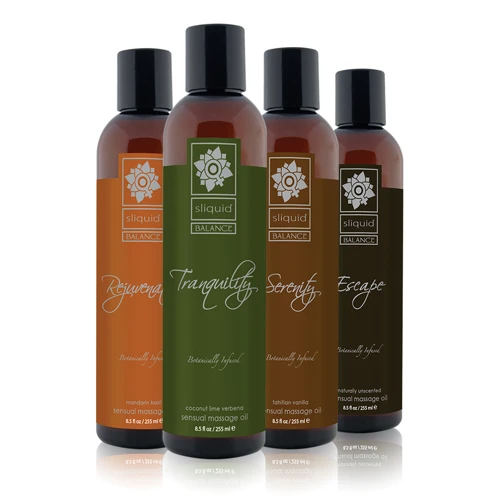
- Almond Oil: Almond oil is a light, non-greasy oil that is rich in Vitamin E, making it ideal for moisturizing and nourishing the skin. It is also known for its anti-inflammatory properties and can help soothe sore muscles.
- Coconut Oil: Coconut oil is another popular choice for massage, as it is rich in Vitamin E and other nutrients. It is also known to be very hydrating and can help to improve the skin’s elasticity.
- Olive Oil: Olive oil is a popular choice for massage because it is rich in antioxidants, which can help to protect the skin and improve its texture. It is also known to be nourishing and hydrating.
- Grapeseed Oil: Grapeseed oil is a light, non-greasy oil that is rich in antioxidants and Vitamin E. It is known to be very hydrating and can help to improve the skin’s elasticity.
- Jojoba Oil: Jojoba oil is a light, non-greasy oil that is rich in vitamins and minerals. It is known to be very hydrating and can help to improve the skin’s elasticity.
- Avocado Oil: Avocado oil is a rich, emollient oil that is known to be very nourishing and hydrating. It is also known to be anti-inflammatory, which can help to soothe sore muscles.
Essential Oils for Massage
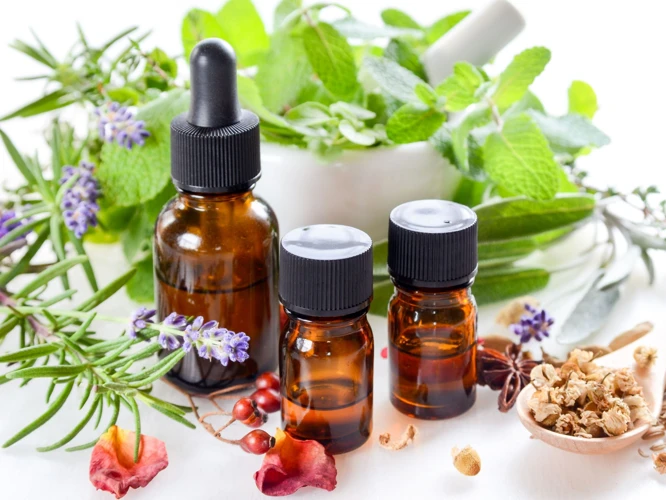
Essential oils are often used in massage therapy to help promote relaxation and wellbeing. Different essential oils have different properties, and can be used to target specific issues such as pain relief, stress relief, muscle relaxation and more.
Table of Essential Oils
| Essential Oil | Benefits |
|---|---|
| Lavender | Relaxation, Stress Relief, Improved Sleep |
| Peppermint | Pain Relief, Improved Digestion, Improved Circulation |
| Eucalyptus | Decongestant, Anti-inflammatory, Pain Relief |
| Rosemary | Increased Circulation, Improved Memory, Stress Relief |
| Chamomile | Relaxation, Stress Relief, Improved Sleep |
Essential oils should be diluted with a carrier oil such as almond or jojoba oil before being used in massage. It is important to be aware of the properties of each essential oil, as some of them can be irritating to the skin. It is also important to be aware of any potential drug interactions.
Benefits of Essential Oils for Massage
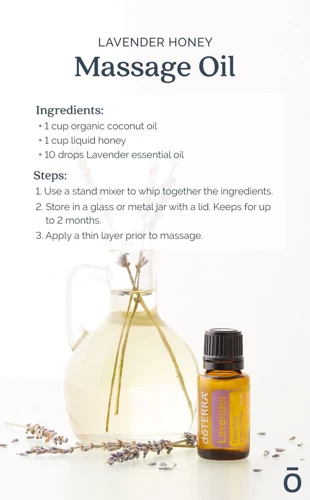
- Relieves Stress and Anxiety: Essential oils can help to reduce stress and anxiety, as they have calming and soothing properties.
- Reduces Muscle Soreness: Essential oils can help to reduce muscle soreness and tightness, as they can penetrate deep into the muscles and relax them.
- Increases Circulation: Essential oils can help to increase circulation and improve the flow of oxygen to the muscles.
- Improves Skin Health: Essential oils can improve skin health and appearance by hydrating and nourishing the skin.
- Relaxes the Mind and Body: Essential oils can help to relax and restore the body, leading to a better night’s sleep and an overall feeling of relaxation.
- Aids in Detoxification: Essential oils can aid in the process of detoxification, helping to flush out toxins from the body.
Selecting the Right Massage Oil
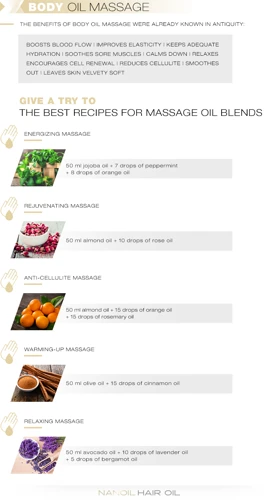
When selecting massage oil, there are several factors to consider: scent, viscosity, and skin compatibility.
- Scent: Aromatherapy oils can be added to massage oils to create a pleasant fragrance. Choose something that is soothing and relaxing.
- Viscosity: Oils with a thicker viscosity will take longer to absorb into the skin, making them ideal for deep tissue massage. Thinner oils are better for lighter massage styles.
- Skin Compatibility: Choose an oil that is compatible with your skin type. If you have sensitive skin, opt for an oil that is hypoallergenic and/or dermatologist-tested.
When selecting massage oil, always read the label to make sure it is safe to use and is suitable for your skin type. If you have any doubts, consult with a professional therapist before using any type of massage oil.
How to Store Massage Oils
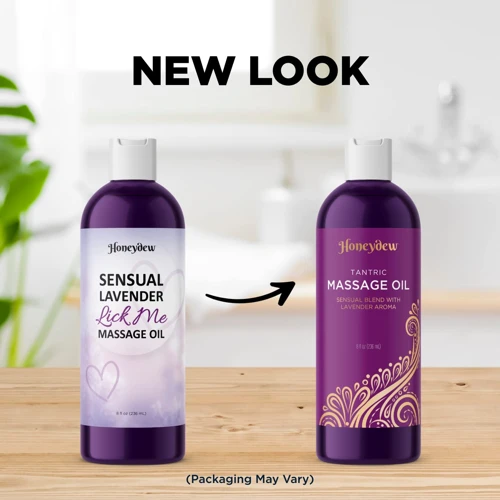
Massage oils should be stored in a cool, dark place, such as a closet or cupboard. It’s important to keep the oils away from direct sunlight, as this can cause the oils to degrade and go rancid. The ideal temperature for storing massage oils is between 60-80°F. If the temperature exceeds or drops below this range, it can affect the quality and shelf life of the oils.
It’s important to keep the lid on the massage oils tightly closed when not in use. This will help prevent oxidation and contamination from dust, dirt, and other particles. Additionally, it’s important to keep massage oils away from any flame or heat source, as this can cause them to become unstable and flammable.
If stored properly, massage oils can last for up to two years. It’s important to check the “use by” date on the bottle to ensure optimal freshness. Additionally, it’s important to check the oil’s color, consistency, and fragrance to ensure that it is still in good condition.
In conclusion, it’s important to store massage oils in a cool, dark place away from direct sunlight, flames or heat sources, and to make sure the lid is tightly closed when not in use.
Where to Get Good Massage Oils
Massage oil is a great way to relax and nourish the skin while providing a soothing massage. Depending on the type of oil used, it can also have a number of therapeutic benefits. But where can you get good massage oils?
- Health food stores and natural food stores usually carry a wide variety of massage oils, from organic and all-natural to chemical-free and aromatherapy-based.
- Many specialty stores specialize in massage oils, offering brands and formulations that may not be available in other shops.
- Online retailers offer a huge selection of massage oils, from organic and all-natural to chemical-free and aromatherapy-based.
- Spas and massage therapists often carry a variety of massage oils and can provide advice on which ones are best for your needs.
- Many drugstores and pharmacies carry massage oils that are formulated with vitamins, minerals, and essential oils.
When purchasing massage oils, it is important to read the labels to make sure that you are getting a quality product. Avoid products that contain synthetic fragrances and preservatives, as these can irritate the skin. Natural ingredients such as essential oils, nut oils, and plant extracts are always a better choice.
Also, make sure that the massage oil is designed to be used on the skin. Some massage oils are designed to be used as massage mediums only, and should not be applied directly to the skin.
Frequently Asked Questions
What Are the Benefits of Using Massage Oil?
Massage oil allows for a smooth glide over the skin, which can help reduce friction and irritation. It can also help to deepen relaxation, as well as help to protect the skin during a massage. Massage oil can also help to nourish and moisturize the skin, improve circulation, and help to relieve muscular tension. Additionally, some essential oils are believed to have therapeutic effects, such as stress relief, and can also have a calming effect on the mind.
Are there any precautions to consider when using massage oil?
Massage oils can cause skin irritation or allergic reactions, so it is important to test the oil on a small area of skin before using it. People with allergies or sensitivities should be especially cautious. Additionally, oils should never be used on broken skin and should be stored properly to avoid spoilage. It is also important to use massage oil that is specifically designed for massage and not regular cooking oils.
What Types of Massage Oil Are Available?
Massage oil is an essential part of a massage therapy session, providing lubrication and reducing friction between the skin and the hands of the massage therapist. Common types of massage oil include sweet almond oil, grapeseed oil, coconut oil, and jojoba oil. Aromatherapy oils may also be added to massage oils to provide additional benefits, such as increased relaxation and stress relief.
What Ingredients are Typically Found in Massage Oil?
Massage oil generally contains a combination of natural plant oils such as almond oil, grape seed oil, jojoba oil, sunflower oil, and avocado oil. These oils are lightweight and non-greasy, making them ideal for massage. Essential oils such as lavender, eucalyptus, and rosemary are often added to massage oil to create an aromatic, soothing experience. Some massage oils also include vitamins and antioxidants such as Vitamin E and Vitamin A to nourish and protect the skin.
How Often Should Massage Oil Be Applied?
Massage oil should be applied liberally and as often as needed to help reduce friction and provide a more comfortable massage experience. For best results, massage oil should be applied before each massage session and reapplied as needed during the session. Depending on the type of massage being performed, massage oil may need to be applied more frequently.
Conclusion
Massage oils can be formulated with different ingredients to provide a range of therapeutic benefits. They can help improve circulation, reduce tension, and soothe sore muscles, as well as provide relaxation and wellbeing. With the right blend of natural ingredients, massage oils can be used to create a soothing and peaceful atmosphere for massage sessions.
References
- A Review of the Physical and Psychological Benefits of Massage Therapy
- Massage Oil Types Used in Massage Therapy
- Massage Oil – Wikipedia










